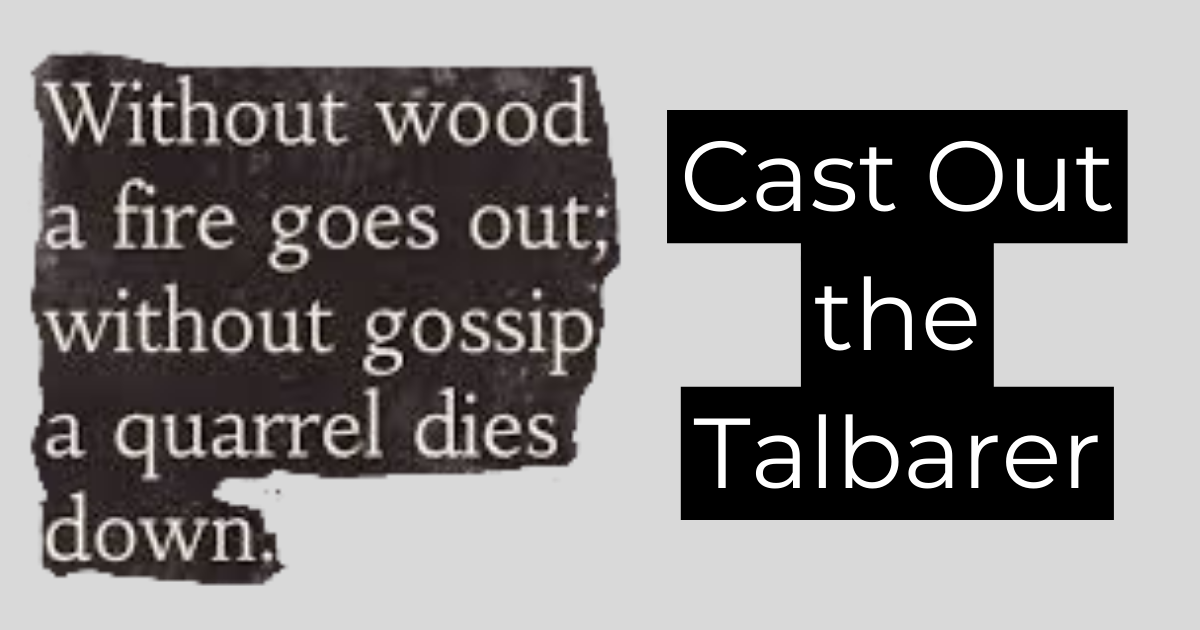The phrase “cast out the talbarer” might seem enigmatic at first glance, but it carries significant weight in various cultural, historical, and spiritual contexts. Understanding this concept requires delving into its origins, implications, and applications across different eras. At its core, “cast out the talbarer” refers to the act of removing or expelling something deemed undesirable or malevolent. This idea spans from ancient rituals to modern practices, making it a compelling subject for exploration. Whether viewed through a historical lens or a contemporary perspective, grasping the essence of “cast out the talbarer” provides valuable insights into human behavior, societal norms, and spiritual beliefs.
Importance of Understanding This Topic
Grasping the concept of “cast out the talbarer” is crucial for several reasons. Firstly, it sheds light on historical practices and their evolution over time, offering a window into how societies have dealt with perceived threats or disturbances. Secondly, it helps us understand the symbolic and metaphorical meanings associated with expulsion or removal in various cultural contexts. Lastly, it provides a deeper appreciation of how ancient rituals and beliefs continue to influence modern practices and thought processes. By studying this concept, we gain a richer understanding of human history and culture.
Historical Context of the Talbarer
Origins of the Talbarer
The term “talbarer” has its roots in historical and cultural contexts that span various civilizations. Originating from ancient traditions, the talbarer was often associated with spiritual or supernatural entities. In many early societies, such as those in Mesopotamia and Ancient Egypt, the talbarer represented a force or presence that required expulsion or control. Historical texts and artifacts suggest that the talbarer was often viewed as a disruptive or malevolent force that could affect the well-being of individuals or communities. Understanding these origins helps us appreciate how the concept has evolved and adapted through different historical periods.
Historical Significance
Throughout history, the act of casting out the talbarer has been significant in shaping cultural and spiritual practices. In ancient rituals, expelling the talbarer was believed to restore balance and harmony. This practice was not only a means of addressing perceived threats but also a way of reinforcing societal norms and values. For instance, in ancient religious ceremonies, the act of casting out was often accompanied by specific rites and offerings, aimed at appeasing deities or spirits. The historical significance of this practice highlights its role in maintaining social order and spiritual equilibrium.
The Concept of Casting Out
Definition and Meaning
To “cast out” refers to the act of forcibly removing or expelling something, typically an unwanted entity or influence. In the context of the talbarer, casting out involves a deliberate action aimed at eliminating a disruptive or malevolent presence. This concept is prevalent in various traditions and can be understood as both a physical and symbolic act. Physically, it might involve rituals or ceremonies designed to remove negative influences. Symbolically, casting out represents the effort to rid oneself or a community of harmful or disruptive elements, thereby restoring order and balance.
Cultural and Religious Perspectives
Different cultures and religions have unique interpretations of casting out entities. In Christianity, for example, casting out demons or evil spirits is a common theme in exorcisms and spiritual healing practices. Similarly, in Hinduism, rituals to cast out malevolent spirits are integral to certain ceremonies and festivals. Each cultural and religious perspective provides insights into how societies address and manage perceived threats or disturbances. By examining these varied interpretations, we gain a broader understanding of how the concept of casting out the talbarer is perceived and practiced across different traditions.
Key Theories and Interpretations
Popular Theories
Several theories attempt to explain the concept of “cast out the talbarer.” One prominent theory suggests that the talbarer represents internal psychological conflicts or external societal issues. According to this view, casting out the talbarer is not just about addressing spiritual or supernatural concerns but also about confronting and resolving underlying psychological or social problems. This theory posits that the act of casting out serves as a metaphor for overcoming personal or collective challenges, thereby promoting healing and growth.
Alternative Interpretations
Alternative interpretations of “cast out the talbarer” offer diverse perspectives on its meaning and significance. Some scholars argue that the talbarer symbolizes natural forces or environmental challenges rather than spiritual entities. In this view, casting out the talbarer is seen as a way of managing or mitigating natural threats, such as diseases or disasters. Other interpretations focus on the symbolic aspects of the concept, suggesting that casting out represents the removal of negative influences or behaviors from individuals or societies. These alternative views provide a richer understanding of the various dimensions of the concept.
Case Studies and Examples
Historical Examples
Historical case studies of casting out the talbarer reveal how ancient societies dealt with perceived threats or disturbances. For instance, ancient Mesopotamian texts describe rituals performed to expel malevolent spirits or entities believed to cause illness or misfortune. Similarly, in Ancient Egypt, rituals involving the casting out of talbarer were performed to protect individuals and communities from supernatural harm. These historical examples illustrate the diverse ways in which different cultures approached the concept of casting out and highlight its significance in maintaining societal and spiritual balance.
Contemporary Examples
In modern times, the concept of casting out the talbarer continues to manifest in various ways. For example, contemporary spiritual practices often include rituals or ceremonies aimed at removing negative influences or energies. In addition, psychological approaches to mental health sometimes involve metaphorical interpretations of casting out harmful thoughts or behaviors. These contemporary examples show how the concept has evolved and adapted to modern contexts, reflecting its ongoing relevance and significance in addressing personal and societal challenges.
Symbolism and Metaphors
Symbolic Meanings
The concept of “cast out the talbarer” carries rich symbolic meanings across different cultures and contexts. Symbolically, casting out can represent the removal of obstacles or barriers to personal or collective well-being. It often signifies a transformative process, where the removal of negative or disruptive elements leads to a renewed sense of harmony and balance. This symbolism is evident in various rituals and practices, where casting out is seen as a way of purifying or cleansing individuals or communities from undesirable influences.
Metaphorical Uses
In literature and speech, “cast out the talbarer” is often used metaphorically to describe the process of overcoming challenges or adversities. For example, a person might be said to “cast out the talbarer” of self-doubt or fear when they successfully confront and overcome these internal barriers. This metaphorical usage highlights the broader application of the concept, extending beyond literal interpretations to encompass personal growth and transformation. By examining these metaphorical uses, we gain insight into how the concept resonates in different aspects of human experience.
Impact on Society and Culture
Societal Impacts
The act of casting out the talbarer has had a significant impact on societies throughout history. In many cultures, rituals and ceremonies involving the casting out of malevolent entities were crucial for maintaining social order and cohesion. These practices helped to reinforce societal norms and values, providing a means of addressing and resolving conflicts or disturbances. The societal impacts of casting out the talbarer extend to various aspects of community life, including social relationships, collective rituals, and cultural traditions.
Cultural Significance
Culturally, the concept of casting out the talbarer is deeply embedded in traditions and practices. In many cultures, the act of casting out is associated with specific festivals, ceremonies, or rituals that hold cultural significance. For example, certain cultural festivals include elements of casting out to symbolize the triumph of good over evil or to mark important transitions in the community. This cultural significance underscores the enduring relevance of the concept and its role in shaping cultural practices and identities.
The Role in Modern Practices
Current Usage
In contemporary settings, the concept of “cast out the talbarer” is often applied in various spiritual and therapeutic practices. Modern spiritual practitioners may use rituals or ceremonies to address and remove negative influences or energies from individuals or environments. Additionally, psychological and self-help approaches may incorporate metaphorical interpretations of casting out to address personal challenges or obstacles. The current usage of the concept reflects its adaptability and ongoing relevance in addressing contemporary issues and concerns.
Influence on Modern Rituals
Modern rituals and ceremonies continue to be influenced by the concept of casting out the talbarer. For instance, some spiritual practices incorporate elements of casting out to promote healing or personal growth. In addition, contemporary rituals may draw on traditional practices, adapting them to suit modern contexts and needs. This influence on modern rituals highlights the enduring legacy of the concept and its ability to evolve while maintaining its core significance.
Psychological and Emotional Aspects
Psychological Impact
The psychological impact of casting out the talbarer can be profound. For individuals undergoing spiritual or therapeutic practices, the process of casting out can lead to a sense of relief and empowerment. By addressing and removing negative influences or internal conflicts, individuals may experience improved mental health and emotional well-being. This psychological impact underscores the importance of addressing both external and internal factors in the process of casting out.
Emotional Reactions
Emotional reactions to the concept of casting out the talbarer can vary widely. Some individuals may feel a sense of liberation or renewal following the removal of negative influences. Others may experience fear or anxiety during the process of casting out, especially if it involves confronting deeply held beliefs or fears. Understanding these emotional reactions provides insight into the complex interplay between psychological, emotional, and spiritual aspects of the concept.
Comparative Analysis
Comparison with Similar Concepts
Comparing “cast out the talbarer” with similar concepts in other cultures or religions reveals both similarities and differences in how societies address perceived threats or disturbances. For example, the concept of exorcism in Christianity shares similarities with casting out in terms of removing malevolent entities. However, the specific practices and rituals may differ. By examining these comparisons, we gain a deeper understanding of how different cultures approach the idea of casting out and the ways in which these approaches reflect broader cultural and spiritual beliefs.
Cross-Cultural Perspectives
A cross-cultural perspective on “cast out the talbarer” highlights the diverse ways in which different societies interpret and practice the concept. For example, while some cultures emphasize spiritual or supernatural aspects, others may focus on psychological or social dimensions. This cross-cultural analysis provides valuable insights into how the concept is adapted and understood in various contexts, reflecting the richness and diversity of human beliefs and practices.
Expert Opinions and Scholarly Research
Insights from Experts
Experts in various fields, including anthropology, psychology, and religious studies, offer valuable insights into the concept of “cast out the talbarer.” These insights help to illuminate the different dimensions of the concept, from its historical origins to its contemporary applications. Experts may provide analysis on the symbolic meanings, psychological impacts, and cultural significance of casting out, contributing to a more comprehensive understanding of the topic.
Relevant Research Studies
Relevant research studies provide empirical evidence and theoretical frameworks for understanding “cast out the talbarer.” Scholarly research may focus on historical practices, cultural variations, or psychological effects related to casting out. By examining these studies, we gain a deeper appreciation of the concept’s significance and its role in shaping human experience and behavior.
Practical Applications and Implications
Applications in Modern Contexts
In modern contexts, the concept of “cast out the talbarer” can be applied in various practical ways. For example, individuals may use metaphorical interpretations of casting out to address personal challenges or obstacles. Spiritual practitioners may incorporate elements of casting out into their rituals or ceremonies to promote healing or growth. These practical applications demonstrate the ongoing relevance of the concept in addressing contemporary issues and concerns.
Implications for Practitioners
For practitioners, understanding and applying the concept of casting out the talbarer has several implications. It may influence the design of rituals, the approach to therapy, or the way individuals address personal challenges. By exploring these implications, practitioners can better align their practices with the underlying principles of casting out, enhancing their effectiveness and impact.
Challenges and Controversies
Debates and Controversies
The concept of “cast out the talbarer” has been subject to various debates and controversies. Some of these debates revolve around the effectiveness of casting out practices, particularly in the context of spiritual or therapeutic interventions. Others focus on the ethical considerations of performing rituals or ceremonies that involve casting out. These controversies highlight the complexities and challenges associated with the concept, emphasizing the need for careful consideration and respect for diverse perspectives.
Challenges in Interpretation
Interpreting the concept of casting out the talbarer can be challenging due to its multifaceted nature. Different cultural, religious, and psychological perspectives offer varying interpretations of the concept, making it difficult to arrive at a single, definitive understanding. These challenges in interpretation underscore the importance of considering multiple viewpoints and approaches when studying and applying the concept.
Future Directions and Research
Emerging Trends
Emerging trends related to “cast out the talbarer” reflect the evolving nature of the concept in contemporary settings. For example, new research may explore the integration of traditional practices with modern therapeutic approaches. Additionally, emerging trends may highlight the adaptation of casting out rituals to address contemporary issues, such as mental health challenges or social conflicts. These trends provide insights into how the concept continues to evolve and adapt.
Future Research Opportunities
Future research opportunities related to “cast out the talbarer” include exploring its application in diverse contexts and examining its impact on individuals and communities. Research may focus on the effectiveness of casting out practices, the symbolic meanings associated with the concept, or the ways in which it intersects with modern psychological and therapeutic approaches. These research opportunities offer valuable avenues for further exploration and understanding of the concept.
Practical Tips for Understanding and Applying the Concept
Guidelines for Study
To effectively study and understand “cast out the talbarer,” consider the following guidelines: start by exploring historical and cultural contexts to gain a foundational understanding of the concept. Examine various interpretations and theories to appreciate the diversity of perspectives. Engage with scholarly research and expert opinions to deepen your knowledge. By following these guidelines, you can develop a comprehensive understanding of the concept and its significance.
Application in Daily Life
Applying the concept of casting out in daily life involves recognizing and addressing negative influences or challenges. Whether through metaphorical interpretations or practical rituals, the principles of casting out can be used to promote personal growth and well-being. Consider incorporating elements of casting out into your routines or practices to address and overcome obstacles, fostering a sense of balance and harmony in your life.
Conclusion
Summary of Key Points
In summary, “cast out the talbarer” is a concept with deep historical, cultural, and symbolic significance. From its origins in ancient rituals to its modern applications, the concept reflects diverse interpretations and practices. By understanding the historical context, key theories, and practical applications, we gain valuable insights into how societies address perceived threats and disturbances.
Final Thoughts
The exploration of “cast out the talbarer” reveals the complexity and richness of this concept. Its continued relevance in modern contexts highlights the enduring nature of its principles and practices. Whether through historical rituals or contemporary applications, casting out remains a powerful symbol of transformation and renewal. As we continue to study and apply this concept, we contribute to a deeper understanding of human behavior, culture, and spirituality.










